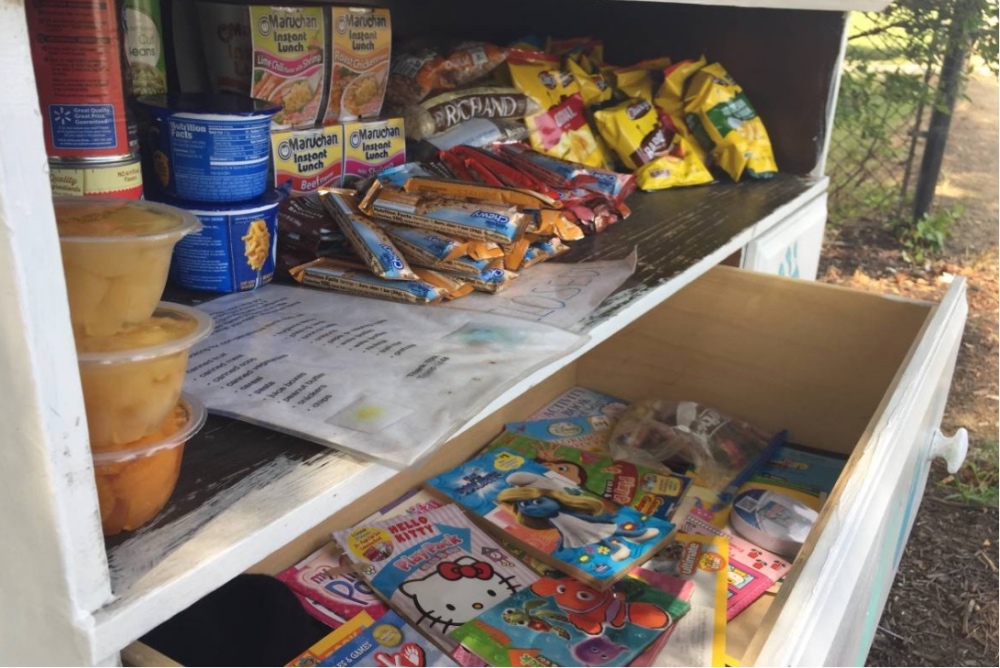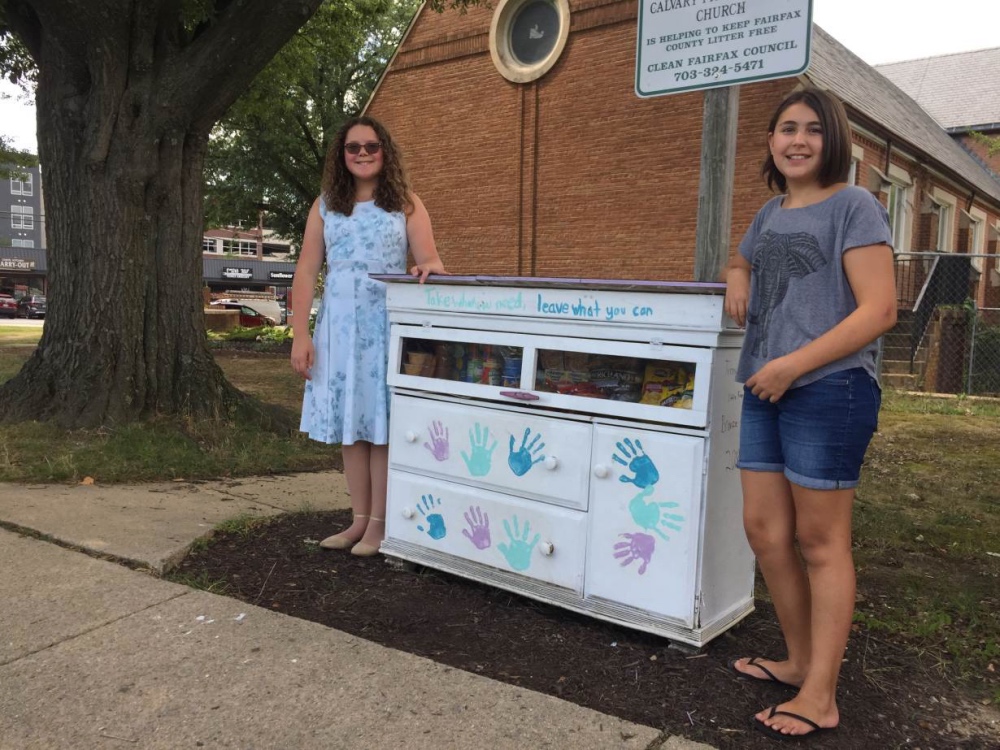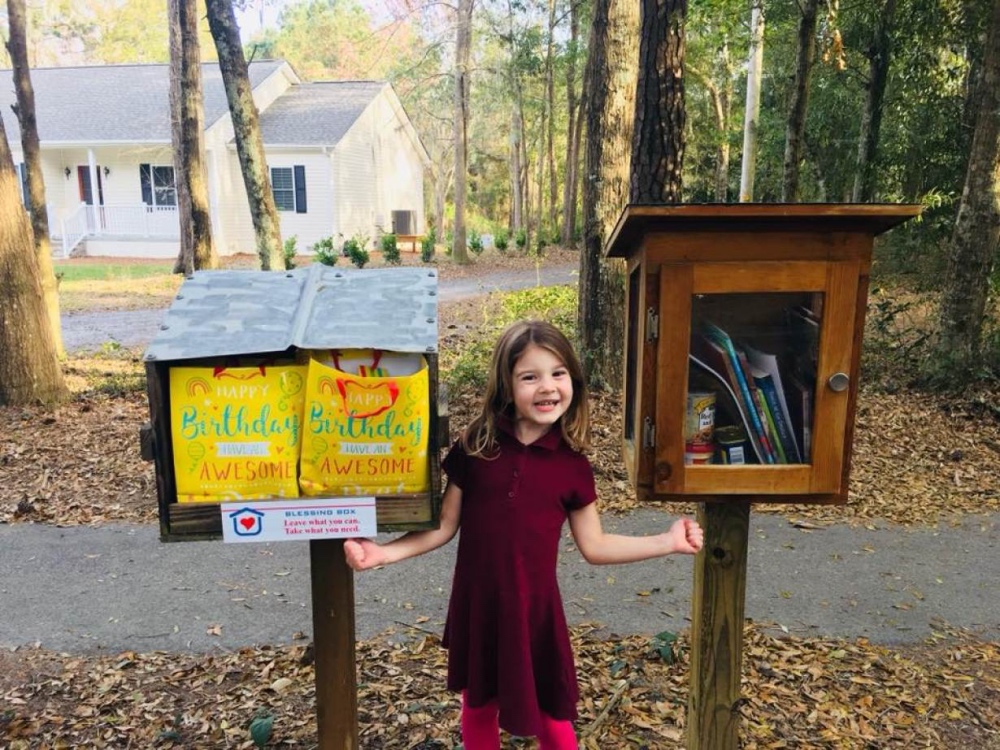
CAREY L BIRON, of Thomson Reuters Foundation, reports on a grassroots movement in the US which is providing those in need 24 hour access to food and other basic necessities they may not normally be able to afford…
Alexandria, Virginia, US
Thomson Reuters Foundation
On a recent Sunday, across the Potomac River from the US capital, two pre-teen girls were dusting off a refurbished dresser near a busy road, stocked with fruit, canned goods, toothpaste, children’s books and more.
Amanda Santana and Anna Rissi, both 12, had placed the dresser in their Alexandria neighbourhood last year and attached written instructions: “Take what you need, leave what you can”.
And to their surprise, many have been doing just that. The area’s residents regularly fill up the “pantry” with non-perishable food items, toiletries and toys to make them readily available – for free – to anyone who needs them, the girls said.
Their local project is part of the global Little Free Pantry movement, which gives those in need 24-hour access in their neighbourhood to food and other basic necessities they may not normally be able to afford.

The Little Free Pantry project in Alexandria, Virginia, holds food items, colouring books, toiletries and more – seen in September, 2019. PICTURE: Carey L Biron/Thomson Reuters Foundation.
The initiative’s founder, Jessica McClard, modelled it off of the Little Free Library project, in which community members and businesses in more than 90 countries have built freestanding boxes in cities where the public can leave and take books.
McClard built the international project’s first free pantry box in 2016, on the grounds of a church in Fayetteville, Arkansas, a state she said is perpetually one of the most food-insecure in the country.
“He said, ‘Today for the first time in a very long time, I had a fresh tomato’. That made me smile.”
– Amanda Santana, 12-years-old, speaking about her conversation with a man who used the food pantry she set up with friend Anna Rissi, also 12.
Many emergency meal providers have irregular hours, but the free pantries are open all day, every day, she said.
And people can use the pantries privately and anonymously, avoiding the “shame” of using federal vouchers at a grocery store – something McClard remembers from having relied on food stamps earlier in her life.
“On the one side, there’s need and shame and judgment,” she said.
“And on the other, there’s trust and compassion – more of a focus on community as opposed to individual responsibility.”
As Santana and Rissi tidied their pantry in Alexandria, they recalled meeting a man who was using it recently.
“He said, ‘Today for the first time in a very long time, I had a fresh tomato,'” Santana told the Thomson Reuters Foundation. “That made me smile.”
Hunger in the United States spiked during the 2008 recession and has only barely recovered to previous levels, according to government data released in September.
The report from the US Department of Agriculture showed that more than 11 per cent of the population lived in “food-insecure” households last year.
And the rate of hunger in the country is likely being exacerbated by other costs: According to 2017 research by Harvard University, households considered “severely burdened” by housing costs spend half of what other households do on food.

Amanda Santana (left) and Anna Rissi stand with their Little Free Pantry project in Alexandria, Virginia, in September, 2019. PICTURE: Thomson Reuters Foundation/Carey L Biron
In the four years since McClard launched the Little Free Pantry movement – with the motto “Feeding Neighbours, Nourishing Neighbourhoods” – it has grown to 670 recorded projects, she said, adding the real figure could be triple that.
The idea has since been picked up across the country and abroad, with projects in Europe, Canada, South Africa, the Philippines, New Zealand and Australia, she said.
Little Free Pantries work best when built on private land that is publicly accessible, she added.
Not only does such property often have fewer regulations than public land, but many churches, schools, businesses and community centres also have ample parking, an element of privacy and a built-in support network.
“We appreciate that [the project] not only supplements our efforts, but also helps to raise awareness about the issue of hunger in America.”
– Zuani Villarreal, spokeswoman for Feeding America.
National anti-hunger organisations have taken notice.
“We appreciate that [the project] not only supplements our efforts, but also helps to raise awareness about the issue of hunger in America,” said Zuani Villarreal, spokeswoman for Feeding America, a network of 200 food banks which in 2018 distributed 4.3 billion meals.
One of the larger Little Free Pantry networks is in South Carolina, where two years ago Katie Dahlheim, motivated by what she said was a polarised atmosphere nationally, built four pantries out of old cabinets.
“I was trying to find something that was universal and everyone can agree on – and everyone has to eat,” she said.
Since then, the Lowcountry Blessing Box project has “exploded,” she said, and today numbers nearly 100 boxes spread throughout a third of South Carolina; two sister projects cover the rest of the state, Dahlheim noted.
The project sees a “huge influx” of need each summer, when kids are out of school and suddenly their families or friends have to find a way to feed them three meals every day, she said.

A girl poses next to a Blessing Box project in Charleston, South Carolina, in March, 2019. PICTURE: Handout photo by Katie Dahlheim
There has been pushback, she acknowledged, with some locals saying a particular box’s presence could snarl up traffic or bring poor people into a neighbourhood.
But Dahlheim said she uses those complaints as an educational opportunity.
“My response has been that poor people are always here – you never know whose mother is sick, for instance. You can’t judge somebody based on what you’re observing,” she said.
In Indianapolis, Sierra Nuckols-Cosby is perpetually on the hunt for old newspaper distribution boxes.
In 2016, just out of college, Nuckols-Cosby became concerned by the city’s “food deserts”, areas where people lack access to grocery stores and their fresh produce and meats.
So, she struck on the idea of creating Little Free Pantries out of decommissioned newspaper boxes.
“My response has been that poor people are always here – you never know whose mother is sick, for instance. You can’t judge somebody based on what you’re observing.”
– Katie Dahlheim, founder of the Lowcountry Blessing Box project, speaking about how she responds to complaints.
Nuckols-Cosby, who works at a social services centre where she focuses on food access, set up the first one in front of her younger brother’s elementary school, and her Community Food Box Project is now up to 55 boxes, she said.
She encourages people to use the sides of the boxes for civic engagement, such as one campaign that painted some of the boxes to raise awareness about mental health problems in black communities.
Another pantry placed in front of an upscale restaurant in a fast-gentrifying area was decorated with a rendition of da Vinci’s Last Supper, showing people eating at a long table and others beneath the table with their mouths open, feeding on scraps.
Angry locals ended up destroying the box, Nuckols-Cosby said.
But that incident underscored the fact that Indianapolis’s poor neighbourhoods are facing a real crisis of access to food, she said, noting that the impoverished area she works in has no grocery stores.
“The reason people were so ready for this is because they see people in their neighbourhoods every day who are hungry, and this is something they can do about it,” she said, of the food box project.
Nuckols-Cosby is now working to establish her project as a non-profit so she can raise money to create a centralised hub that can distribute food items throughout the pantry network.
She just needs a few more newspaper boxes, she said.





